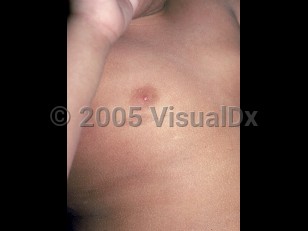Bloom syndrome in Adult
Alerts and Notices
Important News & Links
Synopsis

Bloom syndrome, also known as Bloom-Torre-Machacek syndrome or congenital telangiectatic erythema, is a rare genetic disease caused by a mutation in the BLM gene on chromosome 15q26.1, which encodes RECQL3 helicase. This helicase plays an important role for DNA stability. There are at least several hundred cases reported in the literature. It frequently affects the Ashkenazi Jewish population with a 1% carrier rate, and it is inherited in an autosomal recessive manner.
The cutaneous findings of Bloom syndrome manifest during the first few weeks of life, classically with erythema of the cheeks in a butterfly distribution. Other acute changes include blistering, erythema, and bleeding after exposure to ultraviolet radiation. Chronic cutaneous manifestations include poikilodermic changes, including hypopigmentation, hyperpigmentation, telangiectasias, and atrophy, as well as scarring. Café au lait macules and hypopigmented macules may be observed, especially over the dorsal hands and forearms.
Extracutaneous findings can help with the diagnosis of this rare disorder. A proportionate small stature with a characteristic birdlike appearance is characteristic of Bloom syndrome patients. Other suggestive features that may evolve over time include a high-pitched voice, learning disabilities, diabetes mellitus, and recurrent bacterial infections due to hypogammaglobulinemia. Fertility may be impaired in both females and males.
Importantly, Bloom syndrome is associated with an increased risk of malignancies, which are the leading cause of death. Patients with Bloom syndrome are predisposed to a wide spectrum of malignancies, which reflects that of the general population, making it difficult to implement an effective cancer surveillance system. Although not a malignant process, chronic pulmonary disease, most likely secondary to infections due to hypogammaglobulinemia, is the second-leading cause of death in this population. Life expectancy is often until the second or third decade of life.
The cutaneous findings of Bloom syndrome manifest during the first few weeks of life, classically with erythema of the cheeks in a butterfly distribution. Other acute changes include blistering, erythema, and bleeding after exposure to ultraviolet radiation. Chronic cutaneous manifestations include poikilodermic changes, including hypopigmentation, hyperpigmentation, telangiectasias, and atrophy, as well as scarring. Café au lait macules and hypopigmented macules may be observed, especially over the dorsal hands and forearms.
Extracutaneous findings can help with the diagnosis of this rare disorder. A proportionate small stature with a characteristic birdlike appearance is characteristic of Bloom syndrome patients. Other suggestive features that may evolve over time include a high-pitched voice, learning disabilities, diabetes mellitus, and recurrent bacterial infections due to hypogammaglobulinemia. Fertility may be impaired in both females and males.
Importantly, Bloom syndrome is associated with an increased risk of malignancies, which are the leading cause of death. Patients with Bloom syndrome are predisposed to a wide spectrum of malignancies, which reflects that of the general population, making it difficult to implement an effective cancer surveillance system. Although not a malignant process, chronic pulmonary disease, most likely secondary to infections due to hypogammaglobulinemia, is the second-leading cause of death in this population. Life expectancy is often until the second or third decade of life.
Codes
ICD10CM:
Q82.8 – Other specified congenital malformations of skin
SNOMEDCT:
4434006 – Bloom Syndrome
Q82.8 – Other specified congenital malformations of skin
SNOMEDCT:
4434006 – Bloom Syndrome
Look For
Subscription Required
Diagnostic Pearls
Subscription Required
Differential Diagnosis & Pitfalls

To perform a comparison, select diagnoses from the classic differential
Subscription Required
Best Tests
Subscription Required
Management Pearls
Subscription Required
Therapy
Subscription Required
References
Subscription Required
Last Reviewed:12/14/2016
Last Updated:01/11/2022
Last Updated:01/11/2022

